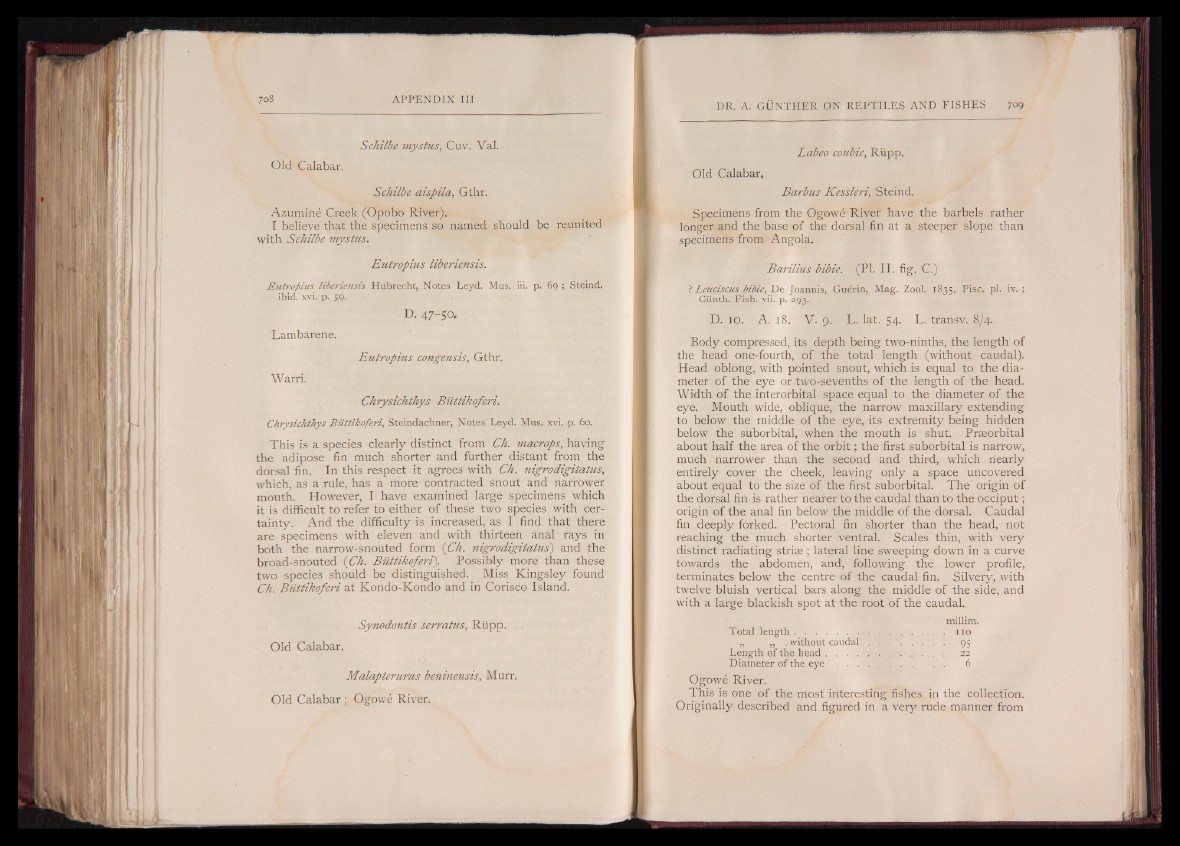
Schilbe mystus, Cuv. Val.
Old Calabar.
Schilbe aispila, Gthr.
Azumine Creek (Opobo River).
I believe that the specimens so named should be reunited
with Schilbe mystus.
Eutropius liberiensis.
Eutropius liberiensis Hubrecht, Notes Leyd. Mus. iii. p. 69 ; Steind.
ibid. xvi. p. 59.
D. 47- 50.
Lambarene.
Eutropius congensis, Gthr.
Warri.
Chrysichthys Biittikoferi.
Chrysichthys Biittikoferi, Steindachner, Notes Leyd. Mus. xvi. p. 60.
This is a species clearly distinct from Ch. macrops, having
the adipose fin much shorter and further distant from the
dorsal fin. In this respect it agrees with Ch. nigrodigitatus,
which, as a rule, has a more contracted snout and narrower
mouth. However, I have examined large specimens which
it is difficult to refer to either of these two species with certainty.
And the difficulty is increased, as I find that there
are specimens with eleven and with thirteen anal rays in
both the narrow-snouted form (Ch. nigrodigitatus') and the
broad-snouted (Ch. Biittikoferi). Possibly more than these
two species should be distinguished. Miss Kingsley found
Ch. Biittikoferi at Kondo-Kondo and in Corisco Island.
Synodontis serratus, Rupp.
Old Calabar.
Malapterurus beninensis, Murr.
Old Calabar ; Ogowe River.
Labeo coubie, Rupp.
Old Calabar,
Barbus Kessleri, Steind,
Specimens from the Ogowe River have the barbels rather
longer and the base of the dorsal fin at a steeper slope than
specimens from Angola.
Barilius bibie. (PI. II. fig. C.)
? Leuciscus bibie, De Joannis, Guerin, Mag. Zool. 1835, Pise. pi. iv. ;
Giinth. Fish. vii. p. 293.
D. 10. A. 18. V. 9. L. lat. 54. L. transv. 8/4.
Body compressed, its depth being two-ninths, the length of
the head one-fourth, of the total length (without caudal).
Head oblong, with pointed snout, which is equal to the diameter
of the eye or two-sevenths of the length of the head.
Width of the interorbital space equal to the diameter of the
eye. Mouth wide, oblique, the narrow maxillary extending
to below the middle of the eye, its extremity being hidden
below the suborbital, when the mouth is shut. Prseorbital
about half the area of the orbit; the first suborbital is narrow,
much narrower than the second and third, which nearly
entirely cover the cheek, leaving only a space uncovered
about equal to the size of the first suborbital. The origin of
the dorsal fin . is rather nearer to the caudal than to the occiput;
origin of the anal fin below the middle of the dorsal. Caudal
fin deeply forked. Pectoral fin shorter than the head, not
reaching the much shorter ventral. Scales thin, with very
distinct radiating striae; lateral line sweeping down in a curve
towards the ahdomen, and, following the lower profile,
terminates below the centre of the caudal fin. Silvery, with
twelve bluish vertical bars along the middle of the side, and
with a large blackish spot at the root of the caudal..
millim.
Total len g th .............................................................110
„ „ , without c a u d a l .......................... . 95
Length of the h e a d ........................ 22
Diameter of the e y e ............................ . . 6
Ogowe River.
This is one of the most interesting fishes in the collection.
Originally described and figured in a very rude manner from